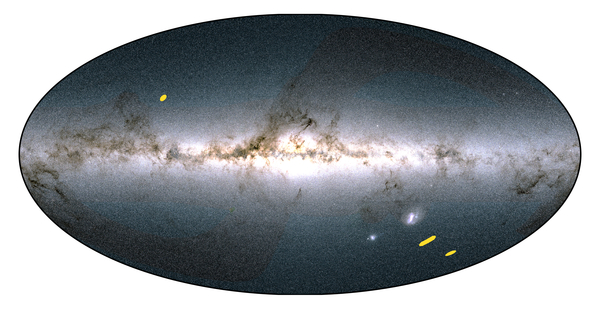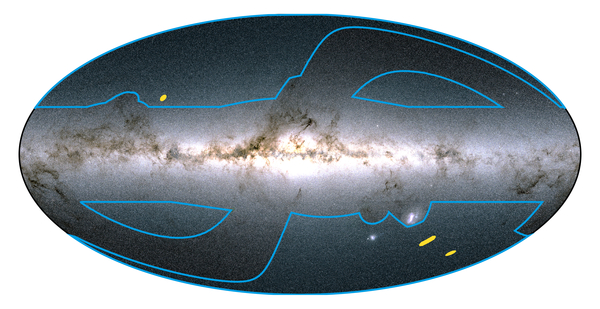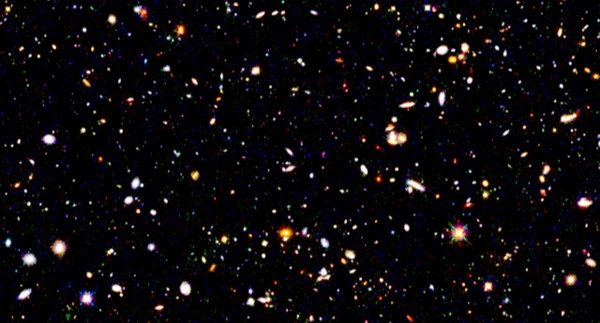Three dark fields for Euclid's deep survey
12 June 2019
Scientists in the Euclid Consortium have selected three extremely dark patches of the sky that will be the subject of the mission's deepest observations, aiming at exploring faint and rare objects in the Universe. The position of the Euclid Deep Fields – one in the northern sky and two in the southern sky – was announced last week, during the annual consortium meeting in Helsinki, Finland. |
| The Euclid Deep Fields. Credit: ESA/Gaia/DPAC; Euclid Consortium. Acknowledgment: Euclid Consortium Survey Group |
With launch scheduled in 2022, ESA's Euclid mission is making great progress on both the hardware and the science preparations. Once in space, Euclid will survey a significant portion of the sky and image billions of galaxies across the Universe to investigate the past ten billion years of our cosmic history.
The largest fraction of the mission's observations will be devoted to the Euclid wide survey, covering about 15 000 square degrees – more than one third of the entire sky – with an unprecedented combination of sharpness and sensitivity.
The observations will enable scientists to investigate two cosmological phenomena: the evolution of how galaxies cluster together over the past 10 billion years, and the distortion of galaxy images due to the presence of ordinary and dark matter intervening between them and us, an effect called gravitational lensing. These two phenomena address the mission's key science goal: delving into the history of the Universe's expansion and characterising the acceleration of this expansion during the last few billion years, something that is thought to be caused by the mysterious dark energy.
In addition, roughly 10% of Euclid's observing time will be dedicated to a deep survey, repeatedly observing just three patches of the sky: the Euclid Deep Fields. The remaining time will be spent for dedicated calibrations of Euclid's two complex, highly sensitive instruments – the visible imager, VIS, and the near-infrared spectro-photometer, NISP.
The three fields were carefully selected to contain a minimum amount of bright Milky Way stars – which 'outshine' faint sources like distant galaxies; of dust particles from the Milky Way's interstellar medium – which obscures the light from faint, distant sources; and of the so-called zodiacal light – the diffuse glow of dust in the Solar System, which affects the sensitivity of the observations.
With a cumulative area of 40 square degrees, equivalent to just over 200 times the footprint of the full Moon in the sky, the Euclid Deep Fields span a portion of the celestial sphere that, while much smaller than the mission's wide survey, is still quite remarkable for a deep survey.
 |
| The Euclid wide and deep surveys. Credit: ESA/Gaia/DPAC; Euclid Consortium. Acknowledgment: Euclid Consortium Survey Group |
"The choice of the Euclid Deep Fields has been a complex process because of many instrumental and scientific constraints, and we are very pleased with this solution that was recently approved by the Euclid scientific community," said Roberto Scaramella from the National Institute for Astrophysics in Italy, Euclid Survey Scientist and lead of the Euclid Consortium Survey Group.
The selection of the fields was presented on 4 June during the annual meeting of the Euclid Consortium, which is led by Yannick Mellier of Institute d'Astrophysique in Paris, France, and comprises 1500 scientists from across Europe, the US and Canada.
One of the three fields, the Euclid Deep Field North, with an area of 10 square degrees, is located very close to the Northern Ecliptic Pole, in the constellation Draco, the dragon. The proximity to the ecliptic pole ensures maximum coverage throughout the year; the exact position was chosen to obtain maximum overlap with one of the deep fields surveyed by NASA's infrared workhorse, the Spitzer Space Telescope.
The other two fields are located in the southern sky. The challenge entailed selecting a region as close as possible to the Southern Ecliptic Pole, which would provide the best coverage, while at the same time avoiding bright sources in that area, which is home to the Large Magellanic Cloud, one of the galactic neighbours of our Milky Way.
The Euclid Deep Field Fornax, also spanning 10 square degrees, is located in the southern constellation Fornax, the furnace. It encompasses the much smaller Chandra Deep Field South, a 0.11 square degree region of the sky that has been extensively surveyed in the past couple of decades with NASA's Chandra and ESA's XMM-Newton X-ray observatories, as well as the NASA/ESA Hubble Space Telescope and major ground-based telescopes.
 |
| Predicted view of the Euclid Deep Field Fornax. Credit: Euclid Consortium (image); NASA/ESA, Hubble, CANDELS, Koekemoer et al. 2011, Grogin et al. 2011 (data) |
The third and largest of the fields is the Euclid Deep Field South, covering 20 square degrees in the southern constellation of Horologium, the pendulum clock. This was the most complex of the three to select because of various technical reasons, also taking into account the capabilities of future ground-based wide field telescopes like the Large Synoptic Survey Telescope. This field has not been covered to date by any deep sky survey and so has a huge potential for new, exciting discoveries.
"We are convinced that the Euclid Deep Fields will become a preferred target in future years for multi-wavelength observations by many telescopes on ground and in space, and hopefully will become as useful and renowned as other famous deep fields surveyed in the past," adds Scaramella.
As opposed to the roughly 30 000 single-visit observations that are needed to cover the Euclid wide survey, each targeting a field slightly apart from the other and with only minimal overlap, the satellite will pay multiple visits to the Euclid Deep Fields. Each field deep field is observed at least 40 times to uncover sources up to two magnitudes fainter than in the wide survey.
The Euclid deep survey has a twofold function: while, on one hand, it provides an accurate data set to validate the main cosmological analysis based on the wide survey, on the other, returning to the same portions of the sky numerous times is also essential for stability monitoring and calibration purposes throughout the course of the mission.
The three deep fields provide a window to examine large amounts of galaxies, looking back to the epoch when the first stars and galaxies formed, which occurred in the first billion year of the Universe's history. Due to cosmic expansion, the light emitted by these galaxies is redshifted to the infrared, so they are best detected at infrared wavelengths, which are poorly accessible from the ground due to Earth's atmosphere. Obtaining data comparable to Euclid's deep survey from the ground would require several tens of years of continuous observing time from the best near-infrared facilities.
Together, the relatively large cumulative area of 40 square degrees, the depth of the survey and Euclid's imaging and spectroscopic capabilities in the infrared maximises the chances of discoveries from the deep survey. The survey will detect several hundred thousand galaxies per square degree; in the case of the most distant sources (with redshift greater than six, corresponding to cosmic epochs when the Universe was less than one billion years old) estimates of the detection rate vary between a few tens to at most a few hundreds of sources per square degree, with the uncertainty being so high due to poor statistics from existing observational data. This will change with Euclid, which can survey an area of this size in a much shorter time than would be needed by Hubble or even the future NASA/ESA/CSA James Webb Space Telescope.
Detections from the Euclid deep survey make for interesting targets for follow-up observations with future facilities such as the James Webb Space Telescope, scheduled for launch in 2021, the European Southern Observatory's (ESO) Extremely Large Telescope (ELT) that is being built in Chile, and next generation radio telescopes like the Square Kilometer Array (SKA) that will be installed in South Africa and Australia in the 2020s. Repeatedly observing the Euclid Deep Fields will also allow for the discovery and analysis of sources whose brightness and properties vary in time.
Currently, there are ongoing programmes to observe parts of the Euclid Deep Fields with Spitzer and several ground-based telescopes: Keck, Subaru, the Gran Telescopio Canarias (GTC) and ESO's Very Large Telescope (VLT). Euclid's deep survey will enable a multitude of exciting and unexpected investigations, especially when combining the data with independent surveys of the same fields to be conducted using other state-of-the-art observatories that will be available in the near future. These include the German-led eROSITA X-ray telescope, due to launch later this month, and the US-led Large Synoptic Survey Telescope, currently under construction in Chile, and NASA's future near-infrared space observatory, SPHEREx.
"The selection of the Euclid Deep Fields is an important moment for the mission, anticipating many discoveries to come," commented René Laureijs, Euclid Project Scientist at ESA.
"If we look at these patches of the sky with the naked eye, they appear quite dull because they are literally empty, devoid of nearby sources of light, and we are looking forward to seeing what Euclid will reveal once it sets its eyes on these dark windows into our cosmic past."
More information
The coordinates of the Euclid Deep Fields and technical details about the deep survey can be found here: https://www.cosmos.esa.int/web/euclid/euclid-survey
Notes for editors
Euclid is an ESA medium class astronomy and astrophysics space mission. ESA selected Thales Alenia Space as prime contractor for the construction of the satellite and its Service Module, with Airbus Defence and Space chosen to develop the Payload Module, including the telescope.
Euclid comprises two instruments: the visible imager (VIS), and the near-infrared spectro-photometer (NISP), whose detectors are provided by NASA.
The Euclid Consortium is a collaboration of nationally funded institutes responsible for the definition of the scientific mission and the provision of the scientific instruments and data processing.
The activities of the Euclid Consortium Survey Group are supported by Portuguese, Italian and French funding agencies.
For more information, please contact:
Roberto Scaramella
Euclid Survey Scientist
INAF – Osservatorio di Roma, Italy
Email: roberto.scaramella![]() inaf.it
inaf.it
Yannick Mellier
Euclid Consortium Lead
Institute d'Astrophysique, Paris and CEA/IRFU/DAp, Saclay, France
Email: mellier![]() iap.fr
iap.fr
René Laureijs
Euclid Project Scientist
European Space Agency
Email: rene.laureijs![]() esa.int
esa.int





